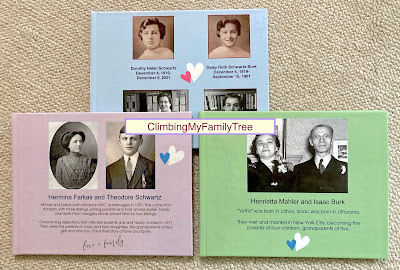As 2023 begins to fade into the history books, a look back at what I thought my priorities in genealogy would be this past year--and what they really turned out to be.
My planned genealogy priorities for 2023
One year ago, I set five priorities for my genealogy activities in 2023: (1) continue writing/posting bite-sized ancestor bios, (2) resume my photo album project, (3) redo research about ancestors of particular interest, (4) continue my genealogy presentations, and (5) further my genealogy education. Oh, and I wanted to clean out the unneeded scribbled notes in my surname files.
My actual genealogy priorities in 2023
Family-history photo books (a variation on bite-sized ancestor bios) turned out to be my absolutely top priority this past year, something that wasn't on my list at all. Why? Because in February, relatives asked questions about what our ancestors did during World War II. I wanted to provide answers that could be saved and reviewed again and again.
In response to the questions, I created my first-ever family-history photo book about
ancestors in WWII. It was only 6 inches by 6 inches, with colorful front and back covers (see image above, from back cover) and 20 pages of info about my Dad (US Army), my uncles (US Army), my aunt (WAC), and my parents' cousins who served in the war (in the US Army, US Army Air Corps, US Marines, US Navy, and National Guard units).
This tiny book was a big hit with the next generation! So I went "all in" on family-history photo books during the year, creating one about my maternal grandparents, one about my paternal grandparents, and one about my Mom and her twin sister. All were well received. Just last month, I completed a photo book about my husband's maternal grandparents, and last week I reordered copies for other relatives after previewing and editing one copy. In all, a very worthwhile priority that will continue into 2024.
In addition, I wrote many bite-sized bios of ancestors to post on WikiTree, Fold3, Find a Grave, and other sites, as I originally planned for 2023, and will continue into 2024.
I began cleaning out handwritten notes from my surname files, saving the info as comments on my trees or otherwise consolidating for less paper clutter. This is something I usually do on the fly while looking for other info in those files.
What slipped to 2024
When those photo books jumped onto the front burner, other priorities had to wait. Now on the back burner is my photo album project, which will show up on the "to do" list for 2024 (more on that in another blog post).
Also slipping to 2024 was some (not all) of my in-depth research on particular focus ancestors, particularly those from Eastern Europe. I'm pursuing a couple of leads and may yet have an interesting breakthrough before the end of 2023.
Genealogy presentations and education
I gave more than a dozen virtual presentations live in 2023, and already have dates lined up for 2024. Continuing my own genealogy education, I watched dozens of excellent webinars (both live and recorded) from a variety of sources: Legacy Family Tree Webinars, Virtual Genealogy Association, WikiTree Symposium, Allen County Public Library Genealogy Center, Center for Jewish History, Jewish Genealogy Society of CT, Kentucky Genealogical Society, and other genealogy groups around the country. I really appreciate the opportunity to learn from experts.
Tip: Always download the handouts when available! Maybe I can't use all of the info or instructions right away, but I might want to consult the handout in the future. I have one digital file where I store handouts and conference syllabi from the past decade. Thank you to the many speakers who put so much detail into their handouts!










































